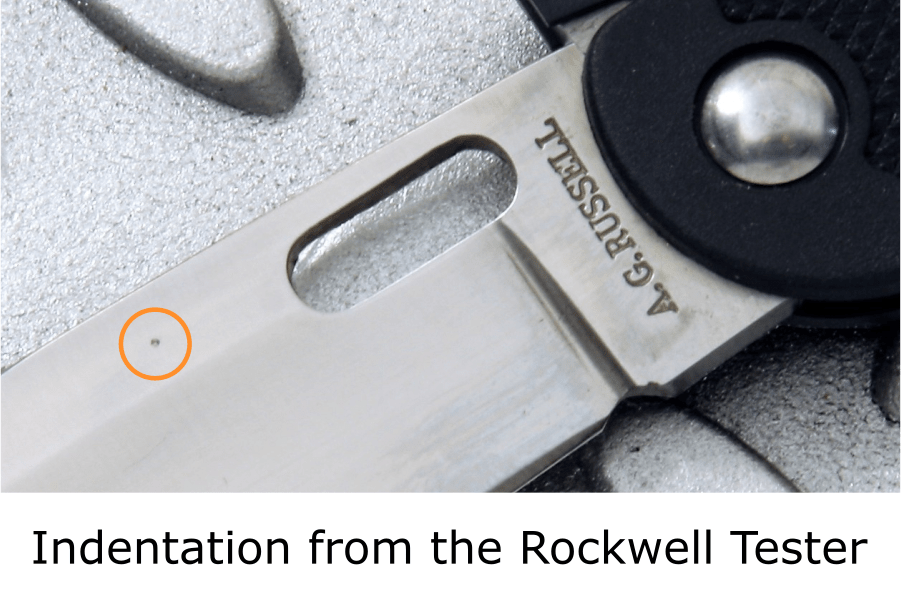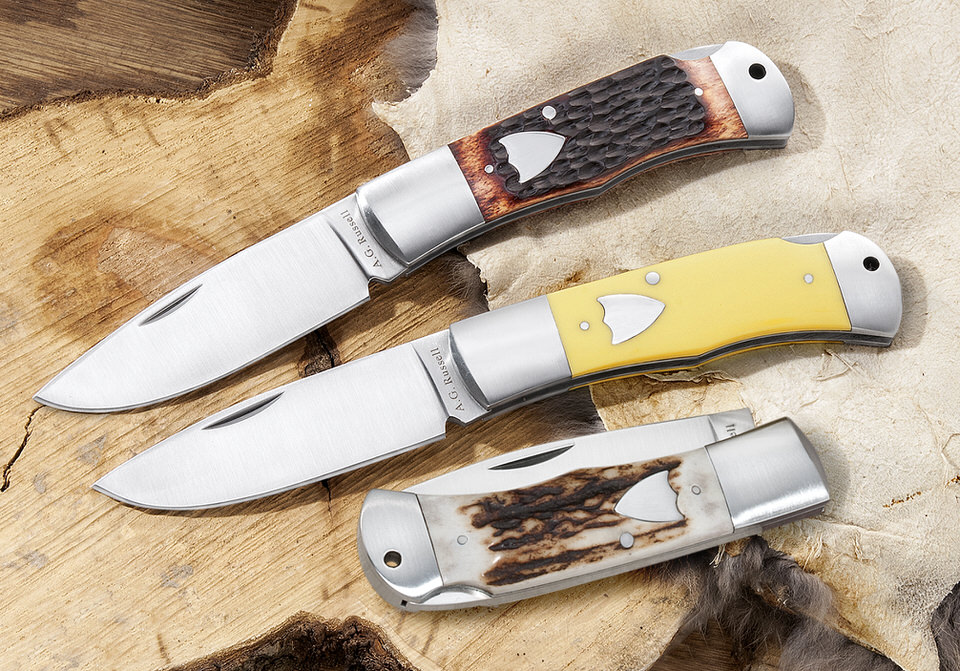Understanding Rockwell
.jpeg)
What is Rockwell?
When looking at knives you will often see a number in the specs with “RC” after it. This number represents the Rockwell Rating. The Rockwell rating is a scale that is used to measure the hardness of a material. An example is stainless steel AUS-8, which usually 57-59 Rc. The Rockwell hardness test is the industry standard for knives. When a range is listed, it means that whatever variation occurs in the hardening process will fall within that range. The range should never be greater than two, in a reliably quality controlled setting. The test does little to no damage to the material being tested, and provides important information about the hardness and durability of the steel. I won’t go into the history of the Rockwell scale, as it is easily learned on Wikipedia.
What does RC stand for?
There are different Rockwell scales of hardness. The important scale for knife steel is Hardness Rockwell Scale C, often shown as HRC, which is further abbreviated to just Rc.
How is the test performed?
This test is performed by measuring the depth of penetration of a diamond tipped indenter under a large load compared to the penetration made by a preload.
This YouTube video by Materials Science 2000 provides a great explanation of the Rockwell Hardness test:
What do the numbers mean practically?
 Now we get to the heart of the matter. This question is somewhat complicated as the most accurate answer is: it depends. But I shall endeavor to give some good rules of thumb.
Now we get to the heart of the matter. This question is somewhat complicated as the most accurate answer is: it depends. But I shall endeavor to give some good rules of thumb.
The exact same steel can be hardened (or tempered) to both a low number, or a high number. However, most steels have a range in which they perform best. Look at my Steel Chart to see what ranges a particular steel usually performs best at.
The higher the number, the harder the steel is. The harder the steel, the better edge retention it will have. The better edge retention, the less often you must sharpen it. On the flip side, the harder the steel, typically the more brittle it is as well. So, then it comes down to preference and blade use. How often are you willing to sharpen it, and what kind of use did you want to use it for (slicing or chopping, etc.).
Many will judge the quality of a steel based on the Rockwell number, with the perception being that higher numbers indicate higher quality steel. Sometimes this is the case, but it is not always what you want, as I will explain in the Softer Steels section below.
Below is a chart showing approximate Rockwell numbers you can expect from different types of blades. This chart is by no means a hard and fast rule, merely an example of typical numbers you might expect.
Softer Steel
Some users like a softer steel, in the 54-56 HRC range. Softer steels require sharpening more often, but they are much easier to sharpen than harder steels. They are also less likely to chip. The edge is more likely to roll over, rather than chip, which is a much easier fix than a chipped blade.
Hard Impact Blades
Hard impact blades like the Ontario Machete (pictured), larger knives, axes, and other machetes often use softer steel. These big blades are put to harder use than smaller everyday carry knives, and must be able to take a lot of brute force without breaking or chipping. A hard impact tool usually ranges in the 52-55 Rc range. A hard impact tool like these needs to find a balance between thickness and steel hardness.
Throwing Knives
Another implement that uses softer steels are throwing knives (and throwing axes). The Boker Bailey Ziel throwing knife is pictured. These blades are Parens, or Spring Tempered. Throwing knives take a lot of force on impact, and the steel must be able to absorb all the force without shattering, so they typically range from 45 - 47 Rc. The edges of a throwing knife should never be sharp. When buying a throwing knife, be sure it is designed to be thrown. Hardened steel knives are dangerous to throw because they may shatter, chip, or break upon hard impact.
Harder Steel
Premium steels range from 59-66 HRC. As modern metallurgy advances, it is entirely possible these numbers might go up. Typically, a good everyday use pocket knife is about 57-59 HRC. You will be perfectly happy with a steel that hard. We have great success hardening 8Cr13MoV to the 57-59 range and it performs admirably. When you start getting into steels higher than 59 HRC, you are most likely buying a premium steel.
Do you need a premium steel? Usually the answer is no. If you just need a knife to carry around and use, then you do not need premium steel. Of course, if you are reading this article you are looking to learn more about knives, and probably DO want to learn about higher grades of steel. Metallurgy is constantly advancing, and has taken steels to whole new levels. Nowadays powdered steels can obtain Rockwell numbers so high that they require ceramic and diamond sharpeners to make any impression on the steel.
Most premium steels will be the 59-64 Rc range. When you get into these ranges of Rockwell, at this point you are near reaching optimum hardness, and going further would just make the steel brittle. So, after reaching these high Rockwell levels, most metallurgists start focusing on improving other important knife properties. There are a lot of other variables steels must contend with to be great - such as sharpenability (how easy it is to sharpen), edge retention, durability, affordability, and rust resistance just to name a few. Some examples of fantastic premium steels are: VG-10, CPM-S30V (and variants), CPM-S110V, 154CM, ZDP-189, M390, and ELMAX, just to name a few.
Some of these steels contend to be the best all-rounders. Some are better at certain properties than others. For example, VG-10 has great edge retention, but what really sets it apart is its ability to maintain a very fine, thin edge. In effect, it is capable of being sharper than many other steels. Its main drawback is that it tends to a little bit more brittle compared to some of the other premium steels - which is why you tend to find it in smaller blades.
So how hard is too hard? Most steels have an acceptable hardening range to obtain optimum retention and toughness. You can probably take an AUS-8 steel to as high as a 66, but it would be so brittle as to be useless.
For my first run of the ACIES, and ACIES 2, I got a super-premium Japanese steel called ZDP-189, which managed to achieve an optimum Rockwell of 64-66. Very impressive steel - very difficult to obtain. Unfortunately, we recently sold out of the ACIES 2. Spyderco has a few very affordable ZDP-189 knives that obtain a Rockwell of 64, such as the three pictured to the left.
Conclusion
The Rockwell test is very important for manufacturers in properly maintaining quality control, but it also offers a measure of quality for the consumer. Knowing the Rockwell can help you guess at how well a blade will perform, and perhaps prevent bad purchases. If you see a folding knife in the low 50s, it could be roughly sharpened on the curb or the blocks of a wall. I’ve seen a few use the bottom of their ceramic coffee mug, or the top of the glass of their car window. If you don’t mind sharpening often, perhaps a softer steel will perform better for you. If you want a knife with a little more quality to it, aim for the 57-59 Rc range. Many of my own knives fall in that range. A little better than average, but still at an affordable price. If you are looking for a premium steel, we offer a great number of fantastic blades. You can use our filters to find what kind of steel you like, or just use the search bar function.
Avoiding poor purchases
If you see an axe significantly above 55 Rockwell, that is probably too hard and will chip in hard use - avoid that purchase. Avoid any throwing knives above 55 Rc as well. If the knife is a folding knife and is much below 54, it is too soft a steel to be used extensively. If you ever aren’t sure, ask us on Facebook or email us.
Not many companies allow customers to see Rockwell ratings, as the numbers are not an exact rating system for quality (only for hardness). However, I think it is important to be transparent with customers, and to try to educate my customers where possible. I always list the Rockwell for my knives. If you see one that is missing, or may be wrong, let us know and we’ll double check it. Being transparent just means I need to take a little more time and explain what the numbers mean. In my opinion, all companies should list what type of steel a blade uses, as well as a Rockwell rating. For other brands we sell, we do our best to try and get the information from the manufacturer so you can make informed decisions. If they happen to list the steel, but not the Rockwell, you can usually find that steel on my Steel Chart to get an idea of probably what Rockwell the steel is tempered at.
Hopefully you now know a lot more about the Rockwell Rating system and what the numbers mean. Thanks for reading.

.jpeg)




